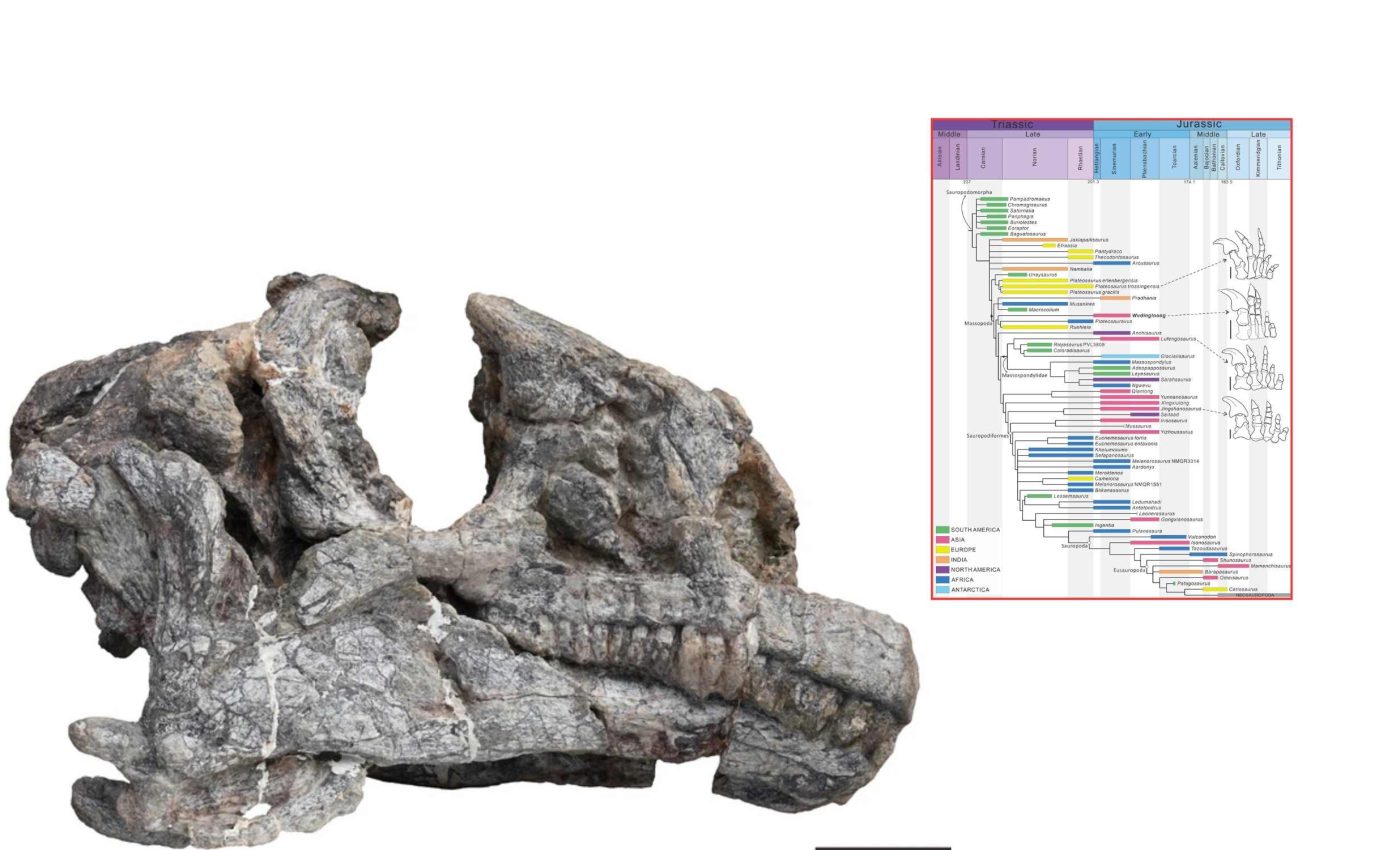
New long-necked dinosaur species lived more than 200 million years ago
A new study describes Wudingloong wui, an early long-necked dinosaur found in Yunnan, China. It is the oldest known member of its group in East Asia, dating to about 200 million years ago.
The fossil comes from rocks that sit at the very base of the Jurassic in the region. That timing makes this species a key marker for when early long-necked dinosaurs first took hold in this part of the world.
Meet the early sauropodomorph
Wudingloong was a member of the sauropodomorphs – an early group of long-necked dinosaurs that would later give rise to giants like Brachiosaurus.
Unlike its massive descendants, this newly identified species was smaller and more lightly built.
The research was led by Ya-Ming Wang at the Geological Museum of China with a team from several Chinese institutions. Their description pins down traits that set Wudingloong apart from other early forms.
The holotype skeleton includes the skull, parts of the neck and back, a shoulder blade, and a forelimb with hand bones. These parts are enough to diagnose a new species with confidence.
“Wudingloong is placed as an earlier-diverging sauropodomorph than Massospondylidae and Sauropodiformes, which adds new information to the sauropodomorph assemblage of southwestern China,” wrote Wang.
What the bones reveal
The skull shows a triangular antorbital fossa, a shallow skull depression in front of the eye opening, on the maxilla. That feature is less common in Chinese relatives and helps separate this taxon from others.
Neck vertebrae carry a sharp ventral keel and show fully closed neurocentral sutures, fused joints between the neural arch and centrum. Those closures indicate the individual had reached adult age.
The forelimb is slender, featuring a flat-topped humeral head and an elongated hand. Its large first claw, or ungual – the terminal bone of the digit – suggests powerful grasping capabilities and perhaps a role in defense.
Why age and place matter
The bones came from the Yubacun Formation, an Early Jurassic rock unit in central Yunnan. The unit marks the lowest dinosaur-bearing layer in East Asia yet recorded, a rare window into the start of the Jurassic.
Geologists place this unit in the Hettangian to early Sinemurian interval, near the dawn of the Jurassic Period. The international timescale sets those stages just after 201.4 million years ago.
In practical terms, that means Wudingloong lived soon after a major turnover in Earth’s ecosystems. The fossil shows that early long-necked dinosaurs were already diversifying in southwestern China at that time.
Shifts in the dinosaur family tree
The team used phylogenetic analysis, a method for inferring evolutionary relationships, to place Wudingloong wui on the sauropodomorph tree. It sits below the clades that lead toward later giants, not among them.
This position aligns with a broader picture of early long-neck evolution. One comparative analysis found that sauropodomorph body plans spread into new forms across the Triassic and Early Jurassic without a single sharp break.
Wudingloong strengthens that pattern by showing a gracile, long-handed form at the base of the Jurassic in East Asia. It adds a new data point where the record was thin.
Lifestyle of the new species
Bone proportions suggest a nimble, mostly two-legged posture rather than a heavy four-legged stance. The large first claw and long fingers support that view.
“It was likely a bipedal dinosaur,” said You Hailu of the Institute of Vertebrate Paleontology and Paleoanthropology, citing the forelimb shape. That matches the limb anatomy described in the scientific report.
Its teeth have smooth enamel and its shoulder blade is slender. Those details match a small herbivore or mixed feeder that did not yet have the massive neck and column-like limbs of later sauropods.
Implications of the discovery
Wudingloong appears closely related to Late Triassic forms from South Africa and Germany. That link hints at dispersal into East Asia either late in the Triassic or right at the Triassic-Jurassic boundary.
The Triassic-Jurassic boundary, the dividing line between those periods, coincides with a global shake-up in species. Early long-necks may have tracked new habitats opening across Pangaea as climates and landscapes changed.
These connections show how one fossil can anchor a bigger biogeographic story. The age and position of Wudingloong wui make it a useful time stamp for that narrative.
A note on extinction and volcanoes
Scientists continue to probe why so many species vanished at the end of the Triassic. One leading hypothesis ties the loss to pulses of magma and gas from the Central Atlantic Magmatic Province around 201.5 million years ago.
Such events could have warmed the climate and acidified oceans. If those changes restructured ecosystems on land, they may have helped early sauropodomorphs expand into new niches during the earliest Jurassic.
That timing is consistent with the age of the Yubacun rocks. It places Wudingloong right after the upheaval, when survivors and newcomers were reshaping food webs.
What scientists still need to learn
One specimen can only say so much. More material from the site could confirm how Wudingloong wui moved, fed, and grew, and whether it shared its habitat with close relatives.
“Further discoveries of more specimens and other analyses are necessary to test this hypothesis,” wrote Wang.
The study is published in the journal Scientific Reports.
—–
Like what you read? Subscribe to our newsletter for engaging articles, exclusive content, and the latest updates.
Check us out on EarthSnap, a free app brought to you by Eric Ralls and Earth.com.
—–













